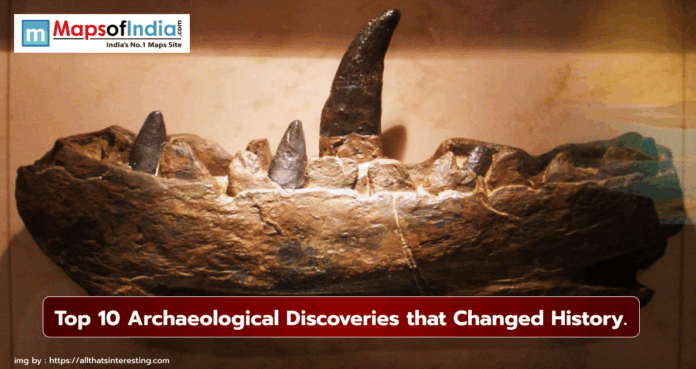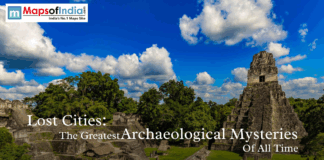The archaeological discoveries reshape our future as we know what our past was. These discoveries uncover lost civilisations and join the missing pieces from the human timelines. In recent years, as technology progressed, new tech like AI aids digs. According to the Archaeology Magazine report, each year, more than 20 major archaeological finds take place. This finding has transformed the history of human civilization we know today, let it be from the Rosetta Stone’s language key to Göbekli Tepe’s ancient temple. These discoveries provide more data on human evolution and societies than we know. According to the Smithsonian study, more than 50% of discoveries since 2000 have been by using ground-penetrating radar.
Rosetta Stone: Unlocking Ancient Languages
The Rosetta Stone was discovered in 1799 by a French soldier. This scribbed stone is located in Egypt‘s Rosetta town. The inscription drawn on these stones is in Greek, Demotic, and hieroglyphs languages. This discovery helped archaeologists to decipher Egyptian writing. With the help of writing on these stones, Jean-François Champollion cracked hieroglyphs in 1822. Due to this discovery, the study of Egypt’s history was opened to the world to read. Many ancient texts from pyramids to papyri became readable. These stones are kept in the Louvre Museum in France. The stones are 112 cm tall. Its impact is immense. It revealed pharaohs’ lives and rituals. Egyptologists were full of joy with this discovery. This discovery changed how we study ancient civilizations.
Dead Sea Scrolls: Biblical Revelations
The Dead Sea Scrolls were discovered in 1947. The shepherds from the Bedouin found these scrolls in the Qumran caves. These scrolls date from the 3rd century BCE to the 1st century CE. According to the Britannica entry, this scroll has over 900 manuscripts. They include Old Testament books. These scrolls are the oldest biblical texts in human history. This scroll has Hebrew Bible consistency. Over 80% contents from the scroll match modern versions. This scroll provides Essene sect insights. According to the Archaeology Magazine report, DNA analysis links them to Qumran. The scrolls are on parchment and papyrus. These scrolls measure up to 8 meters long. The discovery of these scrolls revolutionized biblical studies.
Tutankhamun’s Tomb: Pharaoh’s Treasures
The tomb of Tutankhamun was discovered in 1922. In the depths of the valley of the king in Egypt, Howard Carter found the tomb. This tomb was intact after 3000 years. According to the Britannica article, there are over 5000 artefacts found in the tomb. The gold mask, which was inside, weighs 11 kg. It depicts the young pharaoh. Tomb KV62 is small but rich. According to the rumours, the tomb curse follows after death. Through these artefacts, you can see 18th Dynasty life. Chariots and jewellery in the tomb show the king’s wealth. More than 1 million visitors visit the Cairo Museum to visit this historical tomb. The discovery boosted the knowledge of Egyptology. It inspired global fascination with pharaohs.
Machu Picchu: The Inca’s Lost City
The lost city of Machu Picchu was rediscovered in 1911. This city was known by the locals here, but for the world, Hiram Bingham rediscovered it in Peru’s Andes. This city was built in 1450 CE by the Incas. This lost city is located at 2430 meters. The total area of this city spans 5 square miles. Terraces and temples show the developed engineering of that time. According to the archaeology reports, no wheels were used in construction. Stones fit without mortar. While this civilization was flourishing, more than 1000 people lived here. The discovery made the world familiar with the Inca civilization. It showed that advanced agriculture and astronomy developed in this civilization. This place is recognized as a World Heritage Site.
Pompeii: Frozen Roman Life
Pompeii was buried in 79 CE by Vesuvius and was rediscovered in 1748. According to the Italian excavation team, it has been revealed that this city preserved a Roman city. According to the recent Britannica article, the ash layer at this place is 6 meters deep. It preserved buildings and bodies. Plaster casts show the final moments of the victim. To this place, each year, more than 2.5 million visitors visit. Frescoes depict daily life. According to the recent Archaeology Magazine article, the DNA analysis of this place reveals a diverse population. The site spans over 66 hectares. It changed the world’s understanding of Roman history.
Terracotta Army: Qin’s Eternal Guard
The Terracotta Army, also known as the Eternal Guards of Qin, were discovered in 1974. The farmer in China, Xi’an, discovered this. It was built in 210 BCE for Qin Shi Huang. According to a recent Britannica study, this place has over 8000 warriors. Each guard is unique with weapons. The area of the site spans over 16300 square meters. This site has over 600 horses and chariots. It reveals the military power of the Qin dynasty. According to the recent UNESCO data, more than 5 million visitors visit yearly. The discovery unveiled ancient craftsmanship.
Lascaux Caves: Prehistoric Art Gallery
The Caves of Lascaux were discovered in 1940. In the Dordogne, some French teens discovered this place. The paintings in these caves were dated to 17000 BCE. This cave has over 600 images. Bulls and horses are the dominant picture in the cave. The cave spans over 250 meters. These caves have received UNESCO status since 1979. The art in these caves shows what life was like in the Palaeolithic era. This discovery changed the understanding of the prehistoric period.
Göbekli Tepe: World’s Oldest Temple
Göbekli Tepe, also known as the world’s oldest temple, was discovered in 1994. This temple is located in Turkey‘s Şanlıurfa and was built around 9600 BCE. The pillars at this place are T-shaped and weigh around 10 tons. This site spans over 22 acres. A VIF India report notes no pottery, pre-agriculture. This place rewrote human history. According to the UNESCO data, more than 150,000 visitors visit yearly. The discovery showed complex societies early.
Olduvai Gorge: Cradle of Humanity
Olduvai Gorge, located in Tanzania, was excavated in the 1930s. Louis and Mary Leakey found fossils at this place. The gorge spans over 48 km. In this place, over 2 million-year-old tools were also discovered. This place draws 50000 researchers each year. The discovery revealed human evolution. According to the Archaeology Magazine article, the footprints at this place are from 3.7 million years ago.
Troy: Homer’s Legendary City
Troy, Homer’s legendary city, was discovered in 1870. Heinrich Schliemann excavated in Turkey’s Hisarlik. The layer found in the city dates to 3000 BCE. A Britannica article says nine cities are stacked. Homer’s Iliad inspired the search for this place. Some gold artefacts were also discovered. The discovery of this place confirmed an epic tale. This place is a UNESCO World Heritage Site.





